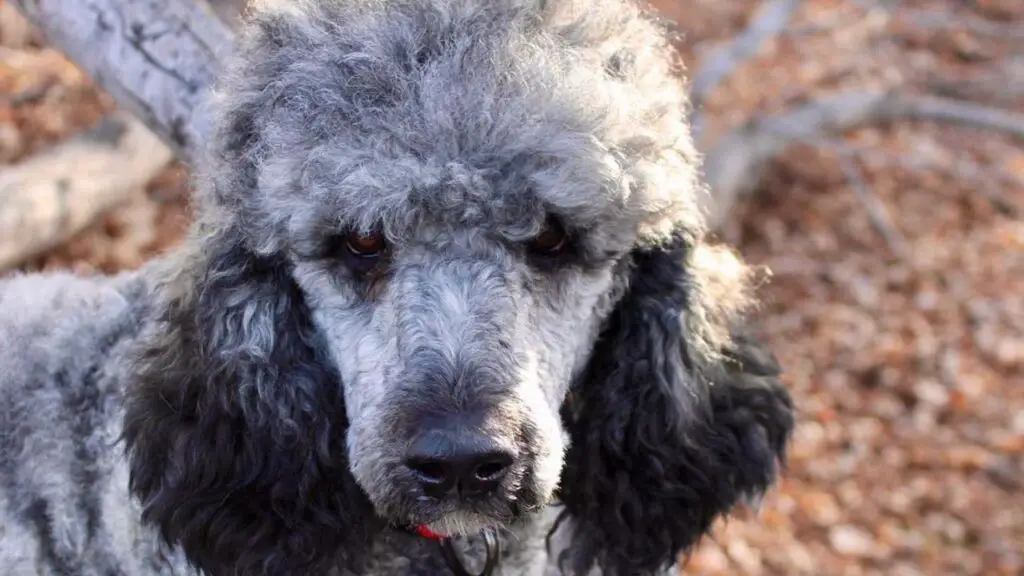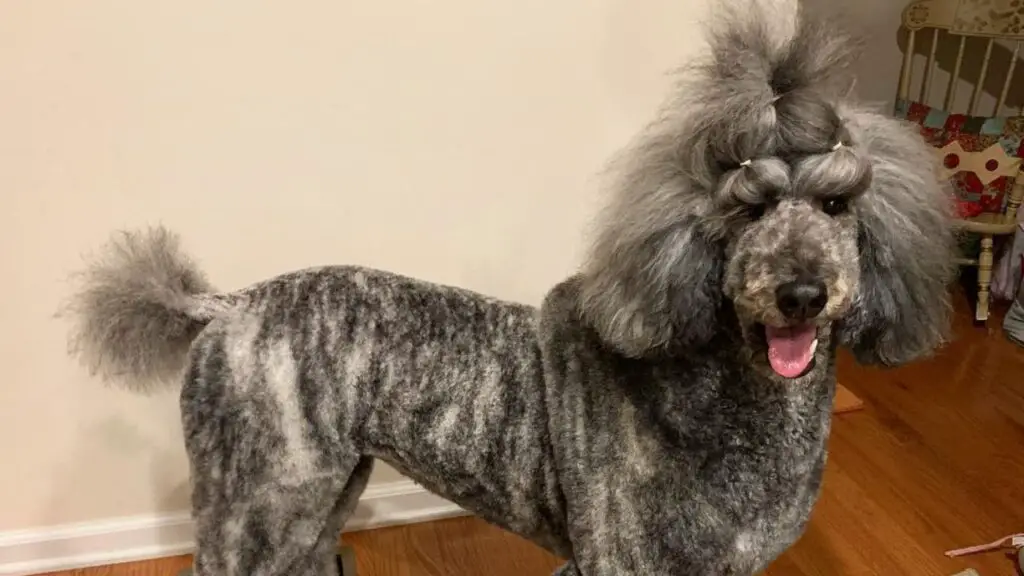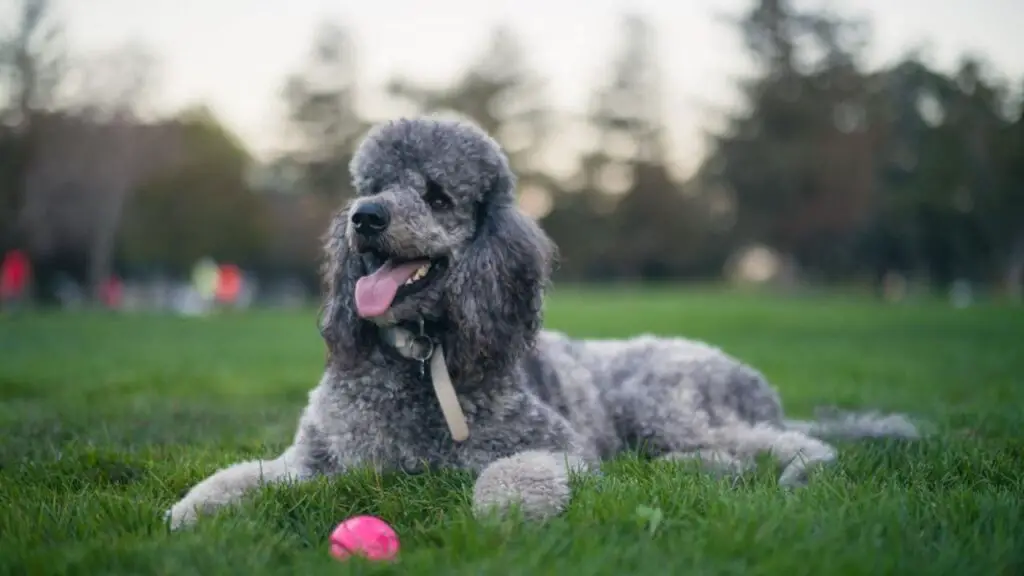There are a lot of fans of non-standard colors of poodles in the world. This is not surprising because such pets have inherited all the positive qualities of poodles, such as high intelligence, devotion, and playfulness. In addition, poodles with a rare color are distinguished by their unimaginable beauty and uniqueness. Of all the varieties of non-standard colors, brindle and sable colors should be distinguished, which are often confused. Therefore, in this article, we’ll take a closer look at these two unique colors and help you understand the difference.

What Will You Learn? 👇
What does a sable poodle look like?
The sable color is one of the most variable colors. It is characterized by the presence of black or dark brown hair tips in combination with light brown hair. However, if you make a short haircut for a sable poodle and cut off the dark ends, then the sable color of the animal will irrevocably disappear. This is the inconsistency of this color.

Sable poodle puppies are born with rich brown coats. At a young puppy age, these poodles look like apricot poodles with black bloom.

Read our Smart Poodles - Smart Tricks eBook for only $2.99
Dive into a treasure trove of engaging tricks and tips designed specifically for your poodle!
Each hair is ginger, but the tip is black.
The hair on the ears, under the legs, and tail is almost entirely black or sometimes dark gray. With age, the hair begins to lighten at the base, acquiring a creamy shade, while the ends remain black. This is especially noticeable on the ears. However, this color always remains unusually elegant, even though some believe that hair with dark ends gives the impression of a dirty coat.
It is believed that this color comes from wolves. If you look at a single sable coat, you will notice that it is multi-colored. The tip of the sable coat is dark, and the base is lighter. Keep in mind that this is only in a sable puppy, not in an adult sable that has already been clipped or shaved. Since the poodle’s coat is continuously growing, it becomes necessary to trim your pet’s coat. Because of this, the dark tips of the sable begin to fade over time. Thus, the sable poodle looks solid with age. However, some sables have a darker tint in their ears, as most people allow the fringe on their pet’s ears to grow rather than cutting it off. It is also very important to understand that sable is a faded color. This means that the puppy’s sable color looks much darker than that of an adult sable.
What does a brindle poodle look like?
Another non-standard color of poodles is brindle color. It usually comes from poodles that have both an apricot and gray ancestor in their pedigree. While the coat is short, such puppies are very elegant. Especially if they are brindle piebald, that is, with white spots. However, then such poodles go through a rather long stage of the “ugly duckling.” It is good if the color gradually fades by the age of one and a half. It is worth noting that the stronger the influence of the silvery ancestors, the more beautiful the resulting color will be. However, it happens that the color change suddenly ends by 7-10 months, and you get a terrible-colored poodle puppy.

The presence of a striped pattern distinguishes brindle poodles, and the primary color can be either dark or light. Individual dark or light hairs are evenly colored along their entire length. The pattern is visible both on the animal’s long fur coat and on the short-haired one. The striped brindle coat is mainly composed of layered black wool mixed with lighter color patches, that is, lighter color with black stripes. Reverse brindle color occurs when the black stripes are so concentrated that the lighter background, although clearly present, is much more muted, giving the impression of a black coat with lighter stripes.
If you look at one brindle hair, you will notice that the hair shaft is a solid color all the way and along the hair shaft. The arrangement of these hairs in the curls, regardless of their color, gives the brindle color a striped pattern. Unlike sable, brindles will always be present in the coat, no matter how often and how short it is stripped. You can see this same pattern in Great Danes, Boxers, Cattle, Afghan Hounds, and several other breeds. Brindle spots, even if they are clean-shaven, show stripes. Moreover, the spotted pattern is more noticeable if the poodle’s coat is short. However, once the coat grows back, it mixes and gives the dog a more uniform color, albeit cloudy.
Genetically brindle is the result of at least two recessive genes.
This means that such poodles are rare and are usually born to parents who both have the same color or from parents whose brindle color is close to their pedigree. However, remember that even the above cases do not always guarantee brindle color.
Raising and training of sable and brindle poodles
The poodle’s innate personality traits, such as intelligence, obedience, and imitation, as well as its inherent sense of shame, make the learning and training process virtually hassle-free. These dogs very quickly memorize commands. So, it is enough for them to explain or show a couple of times what and how to do, and they will remember the lesson forever. Sable and brindle poodle puppies are playful like children, so training should take place in a playful way, where the owner acts as a partner and comrade. The dog begins to perceive human life as a game, tries to imitate people: puts toys in a box and brings the necessary things. Growing up, the poodle literally becomes a person, begins to participate in family household chores actively, and shares its owners’ hobbies.

You cannot shout at the poodle and punish him. In fact, he rarely gives a reason for this. Nevertheless, if the dog has made a mistake, the explanation of its error should not be in a very edifying and tiresome form. It would be best if you shamed your pet briefly and convincingly at the right time and in the right place so that he understands what is at stake.
A poodle is a thinking dog, and this quality must be developed and encouraged: communicate a lot with him, talk, explain your actions, talk about what you expect from him. A poorly educated dog who does not know what subordination is, is likely to feel responsible for the family and show disobedience. This is especially true for miniature and toy poodles.
Health and illnesses of the sable and brindle poodles
Both sable and brindle poodles are fairly hardy and healthy dogs. A poodle puppy for up to a year should be protected from viral and bacterial pathologies, such as plague, hepatitis, and enteritis. Vaccination is carried out with a complex drug, so the dog will be less nervous from visiting the clinic. It is worth noting that you can walk with your puppy two weeks after the last vaccination. However, there are a number of diseases inherent in this breed:
- Addison’s disease (limited production of hormones by the adrenal glands) often resulting in stomach upset and lethargy.
- Bloating, requiring immediate veterinary attention.
- Hypoplasia of the optic nerve, dangerous in that it can cause blindness or distorted perception of the environment.
- PRA, which is retinal atrophy (genetic disease).
- Cushing – a tumor, often malignant, the disease is typical mainly for older dogs.
- Chronic active hepatitis – with this liver disease, it is not possible to cure the dog, but the development of the disease can be stopped.
- Hypothyroidism – a disease of the thyroid gland.
- Deafness.
To protect your dog from the likelihood of contracting these diseases at least once a year, you need to take him to a veterinary clinic for a routine examination.
The owner must ensure that all necessary vaccinations are completed on time. It is also important to treat pets from external parasites from time to time.
Conclusion
There are many colors of poodles, and each unusual coat color gives the dog individuality and uniqueness. Poodles with unusual coat colors are generally much cheaper than their standard counterparts. Still, it is important to note that this does not in any way affect their character and physical capabilities. Therefore, if you buy yourself a pet and you do not want to participate in exhibitions, you should pay attention to the sable and brindle color of poodles.
Brindle color is a very common pattern in the dog world, not only among poodles but also among Danes, Boxers, Mastiffs, and other breeds. The brindle color can be in any color variation, but the unique feature that makes it brindle is the tiger stripes.
Sable is another common color found in the world of dog breeds. It’s important to note that sable is one of the most radically changing color schemes around. At birth, sale poodles look completely different than at six months. Moreover, after full maturation, the only part of their body that has retained its original color is the ears. Therefore, when choosing a puppy by color, remember that sable puppies have this color only for a short time.
The unifying feature of these two colors is the positive character traits inherent in poodles. So, both the sable and the brindle poodles are undoubtedly capable of becoming an excellent companion and loyal friend for a loving and caring owner.
Marko is the founder and author at PoodleHQ, where he blends profound expertise with formal training in Animal Behavior and Canine Genetics. With multiple generations of poodles under his care, he’s a breed connoisseur, honored with the Canine Care Excellence Award and lauded by the International Pet Enthusiasts Association.

